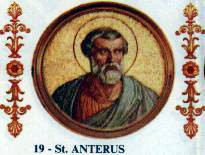Pope Anterus
Pope Saint Anterus | |
|---|---|
 | |
| Papacy began | 21 November 235 |
| Papacy ended | 3 January 236 |
| Predecessor | Pontian |
| Successor | Fabian |
| Personal details | |
| Born | Anterus unknown |
| Died | 3 January 236 Rome, Roman Empire |
| Sainthood | |
| Feast day | 3 January[1] |
Pope Anterus (died 3 January 236) was the Bishop of Rome from 21 November 235 to his death in 236.[2] He succeeded Pope Pontian, who had been deported from Rome to Sardinia, along with the antipope Hippolytus.
Anterus was the son of Romulus, born in Petilia Policastro,[1] Calabria. He is thought to have been of Greek origin,[3] and his name may indicate that he was a freed slave.[4] He created one bishop, for the city of Fondi.[3]
Martyrdom
Some scholars believe he was martyred,[3][5] because he ordered greater strictness in searching into the acts of the martyrs, exactly collected by the notaries appointed by Pope Saint Clement I.[3][6] Other scholars doubt this and believe it is more likely that he died in undramatic circumstances during the persecutions of Emperor Maximinus the Thracian.[4]
Tomb
He was buried in the papal crypt of the Catacomb of Callixtus, on the Appian Way[3] in Rome. The site of his sepulchre was discovered by Giovanni Battista de Rossi in 1854, with some broken remnants of the Greek epitaph engraved on the narrow oblong slab that closed his tomb[6]; only the Greek term for bishop was legible.[5]
His ashes had been removed to the Church of Saint Sylvester in the Campus Martius[3] and were discovered on 17 November 1595, when Pope Clement VIII rebuilt that church.[3]
References
- ^ a b Pope Saint Antherus » Saints.SQPN.com
- ^ Shahan, Thomas (1907). "Pope St. Anterus" in The Catholic Encyclopedia. Vol. 1. New York: Robert Appleton Company.
- ^ a b c d e f g de Montor, Artaud (1911). The Lives and Times of the Popes: Including the Complete Gallery of Portraits of the Pontiffs Reproduced from Effigies Pontificum Romanorum Dominici Basae : Being a Series of Volumes Giving the History of the World During the Christian Era. New York: The Catholic Publication Society of America. pp. 49–50. OCLC 7533337.
- ^ a b Levillain, Philippe (2002). The Papacy: An Encyclopedia. London: Routledge. pp. 63, 557. ISBN 0-415-92230-5.
{{cite book}}: Unknown parameter|coauthors=ignored (|author=suggested) (help) - ^ a b Marucchi, Orazio (2003). Manual of Christian Archeology 1935. Kessinger Publishing. p. 48. ISBN 0-7661-4247-7.
{{cite book}}: Unknown parameter|coauthors=ignored (|author=suggested) (help) - ^ a b Herbermann, Charles, ed. (1913). . Catholic Encyclopedia. New York: Robert Appleton Company.
